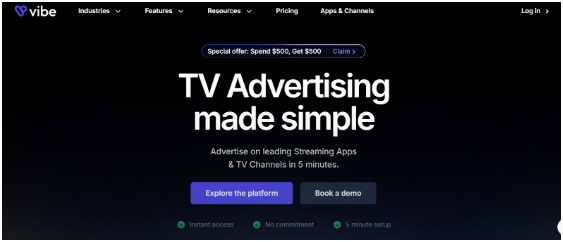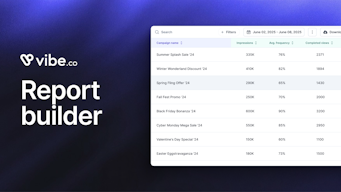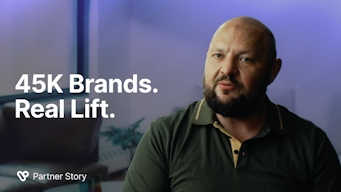5 Ways To Get Your Commercials On TV
Have you ever dreamt of seeing your business on TV? Maybe you’ve thought, “That’s only for big brands.”
But here’s the truth: figuring out how to get your commercial on TV is easier than you think. You just need the right plan.
I’ve seen small businesses, content creators, and even first-time marketers make it happen.
And guess what? It’s not as expensive or complicated as it seems.
So, this blog has got you covered. Here’s what we’ll cover in this blog:
- How to define your goals and budget so you start with a clear plan.
- Steps to create a professional TV commercial that stands out.
- How to choose the best advertising platform, whether it’s local TV, cable, or CTV (connected TV).
- Should you work with professionals or handle it yourself?
- How to track and optimize your campaign to ensure it delivers results.
By the end of this blog, you’ll know exactly how to get your commercial on TV—whatever your budget or experience.
Skip this, and you could miss out on simple tips that save you time, money, and stress. Let’s get started!
How to Get Your Commercial on TV: A Quick Look
| Step | What to Do |
|---|---|
| Step 1: Define Your Goals and Budget | Identify your target audience, set objectives, and plan a production and ad placement budget. |
| Step 2: Create a Professional Commercial | Write a clear script, film with professionals or DIY tools, and focus on storytelling. |
| Step 3: Choose the Best TV Platform | Decide between locla TV, cable, national TV, or CTV (connected TV) based on your audience and goals. |
| Step 4: Work with an Agency or Go DIY | Hire experts for placement and management or contact TV stations directly for a DIY approach. |
| Step 5: Track and Optimize Performance | Use tools to measure engagement, refine your campaign, and maximize ROI. |
Why the TV Advertising Market is Expanding
Despite the rise of digital platforms, TV advertising continues to grow. Let's explore the reasons behind this expansion.
- TV Still Reaches Large Audiences: TV is one of the easiest ways to reach many people at the same time.
- Whether it’s live sports, news, or popular shows, people still spend hours watching TV.
- If your goal is to make your brand visible quickly, TV provides the perfect platform.
- Connected TV (CTV) and Streaming Are Driving Growth: Streaming platforms like Hulu and Roku have made TV advertising even more targeted.
- For example, a fitness brand can show ads to viewers watching workout videos on streaming services.
- This precision makes TV advertising more effective for businesses of all sizes.
- Affordable and Flexible Options for Businesses: TV advertising is no longer just for big brands. Options like local TV and programmatic ads make it affordable.
- If you’re a small business, you can start small and scale as you see results.
- Streaming platforms also let you pay only for the audience you want to target, saving money.
The TV advertising market is growing because it works. It combines wide reach, precise targeting, and flexibility, making it a powerful tool for businesses today.
Now let’s have a look at the five steps to get your commercials on TV:
Step 1 – Define Your Goals and Budget
Let’s start with the basics. How will you create a compelling TV ad if you don't know your goals?
Setting clear goals and a realistic budget will make everything easier—trust me.
Ask yourself a few simple questions:
- What do I want this ad to achieve?
- Am I trying to boost brand awareness, get more sales, or drive leads?
Your answers will guide your ad’s message. For example, if you want more sales, your ad should include a strong call-to-action, like “Shop now” or “Call today.”
Now, think about your audience. Who are you trying to reach? Is it local customers, national viewers, or a specific group? Knowing your audience helps you decide where to show your ad and what tone to use.
When your goals and audience are clear, planning everything else—like your budget and placement—becomes easier.
How to Estimate Your Budget
Once your goals are clear, figure out how much you can spend.
TV ads have three main costs:
- Production: Writing, filming, and editing the ad.
- Placement: Paying for local, cable, or connected TV (CTV) airtime.
- Tracking: Tools to measure how well your ad performs.
If you’re new to this, start small. You can try running your ad on local TV first.
Local TV is more affordable than national but still reaches your target audience.
If you’re considering a DIY ad, you’ll save money but spend more time.
Hiring professionals costs more upfront but often delivers polished, faster results.
Step 2 – Create a Professional TV Commercial
Now that you’ve set your goals and budget, it’s time to bring your idea to life.
A well-made commercial doesn’t have to be complicated but needs to deliver your message.
Let’s break this down step by step.
- Start With the Script
Every great commercial starts with a strong script. It’s the backbone of your message.
First, decide what you want your audience to do after seeing the ad. Is it visiting your store? Making a call?
For example, if you’re promoting a seasonal sale, your script might include a clear call-to-action (CTA) like, “Shop now before it’s gone!”
Keep your message focused on one idea. If your ad tries to say too much, it might lose its impact.
- Plan the Filming and Editing
Once your script is ready, it’s time to plan the production process. This includes deciding where and how to film.
If you’re hiring a production team, discuss your vision and create a filming schedule that aligns with your goals.
For DIY, start by choosing a location—whether it’s your store, an outdoor space, or a simple studio setup.
Use tools like Final Cut Pro or Animoto to organize and edit footage after filming. Plan ahead to avoid delays or unnecessary costs.
- Save Costs Without Compromising Quality
If you have the budget, hiring a professional team is an excellent option. They can handle everything, from filming to editing, and deliver a polished TV commercial.
But if you’re a small business or working with a limited budget, you might wonder if there’s a simpler, more affordable way.
This is where Vibe Studio steps in.
What is Vibe Studio?
Vibe Studio is a free vibe feature designed to help you create professional TV ads. It allows you to create high-quality, TV-ready ads in 2 minutes.
Here’s how it works:
- Enter your business name or a Google link to your business.
- Vibe Studio pulls your business details and images automatically.
- In under 2 minutes, you have a ready-to-use TV ad.
For example, let’s say you own “ Sweet Treats” in New York.
You enter Sweet Treats into Vibe Studio, and it automatically creates a TV ad using your business details and images found online.
In seconds, you have a professional ad ready to go. You can customize it by adding a call-to-action, like “Visit us today!”
So, if budget is a concern, Vibe Studio is the best choice without the need for large production teams and high costs.
Whether you hire professionals or use Vibe Studio, the goal is the same: create ads that resonate with your audience.
Now, let’s move on to the next step!
Step 3 – Select the Best TV Advertising Platform
Choosing the right TV platform depends on your goals, budget, and who you want to reach. Let’s explore your options step by step.
- Local TV Channels: Local TV is a great option if you’re targeting people in your local area.
For example, a bakery could use local TV ads to attract nearby customers to try their new menu. It’s affordable and focused.
But what if you want to reach beyond your neighborhood? Let’s talk about cable.
- Cable TV Advertising: Cable TV gives you a wider reach, covering surrounding cities while staying cost-effective.
For instance, a regional clothing store could run cable ads to promote its seasonal collection across multiple towns.
However, national TV might be the next step when your target audience becomes broader.
- National TV Advertising: National TV is ideal if your brand needs visibility across the country.
Think about a big tech company launching a product—they need ads on major networks for mass exposure.
But national TV is expensive and may not work for smaller budgets.
If you want precision and affordability, connected TV (CTV) is a smarter option.
- Programmatic TV and CTV Advertising: This is where connected TV (CTV) changes the game.
It combines the reach of TV with the targeting power of digital ads.
Platforms like Hulu or Roku allow you to show ads to specific groups, such as parents streaming kids' shows or fitness lovers.
For example, a fitness brand could target viewers watching workout videos, ensuring the right message reaches the right audience.
Unlike traditional TV, CTV is data-driven and ensures your ad reaches the right people at the right time.
Step 4 – Work with an Agency or Go DIY
After choosing your TV platform, the next decision is who will manage your campaign. Should you hire an agency or handle it yourself?
Let’s explore both options.
- Why Consider a Media Placement Agency?
Agencies make the process easier by handling everything for you.
They negotiate ad slots, plan your campaign, and ensure your ads are in the right places.
For example, if you’re running ads on CTV and cable, an agency can manage it all while you focus on your business.
Agencies also bring expertise, helping you avoid mistakes and get the most out of your budget.
But remember, hiring an agency can be expensive, and you’ll have less control over the campaign.
- How to Choose the Right Agency
If you decide to work with an agency, pick one with experience in your field.
For instance, a retail business might choose an agency that knows local TV and seasonal promotions well.
Make sure they offer clear pricing. Ask for a detailed breakdown to know exactly what you’re paying for.
- What About Doing It Yourself?
Managing your campaign gives you complete control but requires time and effort.
You can start by contacting local TV stations or using programmatic platforms to run CTV ads.
For example, tools like Hulu Ad Manager make it easier to target specific audiences without needing an agency.
DIY campaigns can save money, but they can feel overwhelming if you’re unfamiliar with the process.
If you’re handling everything independently, using the right tools can make things much easier.
Whether you choose an agency or go DIY, understanding your needs and budget will help you decide.
Now, let’s look at how to track your campaign and get the best results.
Step 5 – Track and Optimize Your Campaign’s Performance
Once your ad is live, tracking its performance is next. This shows you what’s working and what isn’t.
- Why Measuring Ad Performance Matters?
Tracking helps you understand if your ad reached the right audience.
- For example, you can measure how many people watched your ad and how they responded.
- If your goal is more website visits, tracking shows if people took action after seeing your ad.
Without tracking, it’s hard to know whether your ad delivers results or needs changes.
- How Vibe Helps You Track Ad Performance Effectively

Tracking your ad’s performance is essential, and Vibe.co makes it simple and actionable.
Here’s how it helps:
- Simplifies Tracking with Clear Insights:
Vibe provides detailed data about your ad’s performance, such as:
- Viewership: How many people watched your ad.
- Engagement: How viewers interacted with your content.
- ROI: Whether your campaign delivered measurable returns.
This data lets you understand what’s resonating with your audience and what needs improvement.
- Tracks Connected TV (CTV) Ads:
If you’re running ads on CTV platforms like Hulu or Roku, Vibe gives you precise insights into viewer interaction.
- For example, it can show how many viewers completed your ad or clicked through to your website.
- This ensures your CTV ads don’t just air—they engage the right audience.
- Combines TV and Online Metrics:
Vibe goes a step further by merging TV ad data with online metrics.
- For instance, it can track website visits or sales triggered by your TV campaign.
- This gives you a complete picture of how your TV ads impact your marketing goals.
- Helps Refine Future Campaigns:
By analyzing performance, Vibe helps you improve.
- If one ad performs better than another, you can adjust your strategy.
- For example, if a specific message resonates more, you can use it in your next campaign for better results.
- Turns Data Into Actionable Decisions:
Vibe ensures your ads don’t just run—they deliver results. Its insights help you:
- Refine your strategy.
- Optimize future campaigns.
- Maximize ROI with every ad.
With Vibe, tracking becomes effortless, and real results back every decision. It’s how you make your TV ads truly count.
Conclusion
Getting your commercial on TV isn’t as complicated as it seems. You just need the right steps to guide you.
Here’s a quick recap of what we covered:
- Define your goals and budget: Decide what you want to achieve and how much you can spend.
- Create a professional TV commercial: Focus on clear messaging and strong visuals to connect with your audience.
- Select the right advertising platform: Choose between local TV, cable, national TV, or CTV based on your goals.
- Work with an agency or go DIY: Pick the approach that fits your needs, budget, and expertise.
- Track performance and optimize: Use tools like Vibe.co to see what works and improve your future campaigns.
If you’ve been wondering how to get your commercial on TV, now you have a clear plan to make it happen.
TV advertising isn’t just for big brands anymore.
With the right plan, it’s accessible to businesses of all sizes—even yours.
And here’s the best part: Vibe.co can simplify tracking and optimizing your campaigns. It turns your TV ads into measurable results.
So, are you ready to learn how to get your commercial on TV and make an impact?
Start planning, follow these steps, and let Vibe help you make every ad count!



